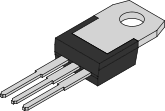TO-220
The TO-220 is a style of electronic component package, commonly used for discrete semiconductors as transistors and silicon-controlled rectifiers, as well as integrated circuits. The "TO" designation stands for "transistor outline".[2] TO-220 packages have three leads. Similar packages with two, four, five or seven leads are also manufactured. A notable characteristic is a metal tab with a hole, used in mounting the case to a heatsink.[3] Components made in TO-220 packages can dissipate more heat than those constructed in TO-92 cases.
Typical applications
The TO-220 package is a "power package" intended for power semiconductors and an example of a through-hole design rather than a surface-mount technology type of package. TO-220 packages can be mounted to a heat sink to dissipate several watts of waste heat. On a so-called "infinite heat sink", this can be 50W or more. The top of the package has a metal tab with a hole used in mounting the component to a heat sink. Thermal compound is often applied to further improve heat transfer from the package to the heatsink.
The metal tab is often connected electrically to the internal circuitry. This does not normally pose a problem when using isolated heatsinks, but an electrically-insulating pad or sheet may be required to electrically isolate the component from the heatsink if the heatsink is electrically conductive, grounded or otherwise non-isolated. Many materials may be used to electrically isolate the TO-220 package, some of which have the added benefit of high thermal conductivity.
In applications that require a heatsink, damage or destruction of the TO-220 device due to overheating may occur if the heatsink is dislodged during operation.
A TO-220 package that is heatsinked, dissipating 1W of heat, will have an internal (junction) temperature typically 2 to 5 °C higher than the package's temperature (due to the thermal resistance between the junction and the metal tab) and the metal tab of the TO-220 package will typically have a temperature of 1 to 60 °C higher than the ambient temperature, depending on the type of heatsink (if any) used.[4][5][6]
The junction-to-case thermal resistance of a TO-220 packaged device (which typically matters less than the case-to-ambient thermal resistance), depends on the thickness and the area of the semiconductor die inside the package, typically in a range between 0.5 °C/W and 3 °C/W (according to one textbook)[7] or 1.5 °C/W and 4 °C/W (according to another).[6]
If more heat needs to be dissipated, devices in the also widely used TO-247 (or TO-3P) package can be selected. TO-3P has a typical junction-to-ambient (heatsink) thermal resistance of only about 40 °C/W, and its TO-3PF variant a slightly lower one.[5] Further increase of heat dissipation capability is possible with power modules.
When a TO-220 package is used without a heatsink, the package acts as its own heatsink, and the heatsink-to-ambient thermal resistance in air for a TO-220 package is approximately 70 °C/W.
Variations
The standard TO-220 outline is defined by the JEDEC organization. There are a number of variations on this outline,[1][8] such as:
- TO-220F, which has an insulated tab and body, and typically has a higher thermal resistance than the metal tab versions.
- TO-220AB
- TO-220AC
Sometimes the designation is followed by the number of leads, as in TO-220AB-5L for five leads, etc.
There also some vendor-specific variations such as International Rectifier's SUPER-220, which dispenses with the hole in favor of clip-mounting, thus claiming TO-247-like thermal performance in a TO-220 footprint.[9]
Common components that use the TO-220 package
- 7805, +5 V linear voltage regulator
- 7812, +12 V linear voltage regulator
- LM317T, adjustable linear voltage regulator
- LM340, linear voltage regulator
- IRF510, N-channel MOSFET (5.6 A, 100 V)
Related packages
- TO-257 is a hermetically sealed metal package that is otherwise considered equivalent to TO-220.[10]
- TO-220F also known as the SOT186 and SC67 is TO-220 like package, where the heatsink mounting tab has been encased in the plastic.[11]
See also
- TO-3, a metal case used for power semiconductors
- TO-263, the surface mount equivalent of the TO-220.
- Chip carrier, Chip packaging and package types list
References
- 1 2 3 "JEDEC TO-220 family package specification" (PDF). JEDEC. March 24, 1987. Archived from the original (PDF) on June 18, 2017.
- ↑ List of semiconductor cases, http://malaysia.rs-online.com/web/generalDisplay.html?id=centre/eem_techref_semipack
- ↑ Torque Recommendations for TO-220 Devices, http://www.vishay.com/docs/72674/72674.pdf
- ↑ "MC7800, MC7800A, NCV7805" (PDF). ON Semiconductor. Retrieved 24 May 2014.
- 1 2 Yong Liu (2012). Power Electronic Packaging: Design, Assembly Process, Reliability and Modeling. Springer Science & Business Media. p. 188. ISBN 978-1-4614-1053-9.
- 1 2 Mike Tooley (2006). Electronic Circuits: Fundamentals and Applications (3rd ed.). Routledge. p. 353. ISBN 978-0-7506-6923-8.
- ↑ Yong Liu (2012). Power Electronic Packaging: Design, Assembly Process, Reliability and Modeling. Springer Science & Business Media. p. 184. ISBN 978-1-4614-1053-9.
- ↑ List of package types, https://www.fairchildsemi.com/evaluate/package-specifications/
- ↑ http://www.irf.com/technical-info/appnotes/an-1000.pdf
- ↑ "Power MOSFETs and IGBTs", Bill Travis, EDN: "[…] and the TO-257 is a hermetic TO-220."
- ↑ http://www.nxp.com/packages/SOT186.html
External links
| Wikimedia Commons has media related to TO-220 transistor packages. |
- TO-220 Package, EESemi.com
- Typical TO-220 devices

